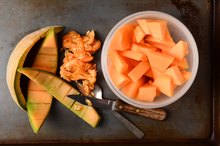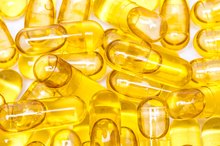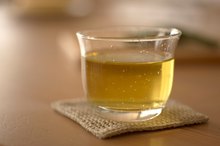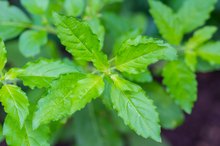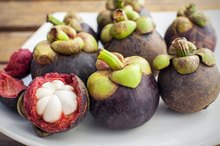What does fact checked mean?
At Healthfully, we strive to deliver objective content that is accurate and up-to-date. Our team periodically reviews articles in order to ensure content quality. The sources cited below consist of evidence from peer-reviewed journals, prominent medical organizations, academic associations, and government data.
- “BioMed Central”; The Use of a Cissus Quadrangularis/Irvingia Gabonensis Combination in the Management of Weight Loss: A Double-blind Placebo-controlled Study; Julius E. Oben, et al.; March 2008
- “BioMed Central”; The Use of a Cissus Quadrangularis/Irvingia Gabonensis Combination in the Management of Weight Loss: A Double-blind Placebo-controlled Study; Julius E. Oben, et al.; March 2008
- “BioMed Central”; The Effect of Cissus Quadrangularis (CQR-300) and a Cissus Formulation (CORE) on Obesity-induced Oxidative Stress; Julius Oben, et al.; February 2007
- “BioMed Central”; The Effect of Cissus Quadrangularis (CQR-300) and a Cissus Formulation (CORE) on Obesity-induced Oxidative Stress; Julius Oben, et al.; February 2007
- “BioMed Central”; The Use of a Cissus Quadrangularis Formulation in the Management of Weight Loss and Metabolic Syndrome; Julius Oben, et al.; September 2006
- “BioMed Central”; The Use of a Cissus Quadrangularis Formulation in the Management of Weight Loss and Metabolic Syndrome; Julius Oben, et al.; September 2006
The information contained on this site is for informational purposes only, and should not be used as a substitute for the advice of a professional health care provider. Please check with the appropriate physician regarding health questions and concerns. Although we strive to deliver accurate and up-to-date information, no guarantee to that effect is made.
How Much Cissus Quadrangularis Is Needed for Weight Loss?
Cissus quadrangularis is a vine belonging to the grape family that originates from Africa and tropical Asia. It has been used in Ayurvedic and African medicine for over 100 years for conditions such as fracture healing, digestive parasites, pain, asthma and irregular periods. Three studies show positive weight-loss effects using CQ, especially in combination with other natural products, but doses vary depending on the combination. Talk to your physician before using herbal remedies to treat any condition.
If you are experiencing serious medical symptoms, seek emergency treatment immediately.
Cylaris Formula
In September 2006, a study published in “BioMed Central” investigated the effect of CQ on obesity 34. Researchers enlisted 92 obese and 31 overweight individuals for placement into four groups: placebo, obese taking formulation without diet intervention, obese taking formulation and dieting, and overweight taking formulation and dieting. Groups received 514 mg twice a day of placebo or Cylaris, a formula containing a minimum of 2.5 percent CQ, soy albumin, green tea extract, caffeine, niacin-bound chromium, selenium, vitamins B-6 and B-12, and folic acid. After eight weeks, the first group lost 5 lbs., the second lost 14.5 lbs., the third lost 18 lbs. and the fourth group lost 8 lbs. Those taking the formula increased HDL, or good, cholesterol by 43 to 50 percent, and decreased total cholesterol and fasting blood glucose levels.
- In September 2006, a study published in “BioMed Central” investigated the effect of CQ on obesity 3.
- Those taking the formula increased HDL, or good, cholesterol by 43 to 50 percent, and decreased total cholesterol and fasting blood glucose levels.
Cissus Quadrangularis and Irvingia Gabonensis
Is it Safe to Take Inositol With an SSRI?
Learn More
A study published March 2008 in “BioMed Central” evaluated the use of CQ in a randomized trial for weight loss 2. Seventy-two people were divided into three groups, one receiving a 250 mg placebo, another 150 mg CQ extract, and the last group a 250 mg combination of CQ and Irvingia gabonensis, a plant also known as bush mango.
At the end of the 10-week trial, with no dietary stipulations or exercise, the average percentage of weight loss per group was as follows: Placebo, 2.1 percent; CQ, 8.8 percent; and CQ/IB, 11.9 percent. The percentage of body-fat loss that resulted was as follows: P-4, CQ-14.6 and CQ/IB-20. Additionally, total and LDL cholesterol and fasting blood glucose levels decreased with the CQ/IB group. A 250 mg dose of CQ/IB appears to be most effective in this study.
- A study published March 2008 in “BioMed Central” evaluated the use of CQ in a randomized trial for weight loss 2.
- The percentage of body-fat loss that resulted was as follows: P-4, CQ-14.6 and CQ/IB-20.
Cissus Quadrangularis and CORE
A February 2007 study published in “BioMed Central” compared the effects of a standard CQ extract called CQR-300, with CORE -- a combination of 7.5 mg CQ and niacin, green tea extract, selenium, soy albumin, folic acid and vitamins B-6 and B-12 -- on obesity 3. Assigned randomly, 153 participants received placebo, CQR-300 or CORE twice a day for six weeks and were assigned a 2,100 daily calorie intake. The CQR-300 recipients experienced a 5.4 percent reduction in body weight, a decrease in fasting glucose of 14.6 percent, a total cholesterol reduction of 18 percent and an increase in HDL of 21.1 percent. The CORE recipients lost 8.5 percent body weight, had a 16.1 percent fasting glucose decrease, a 26 percent decrease in cholesterol and a 43 percent increase in HDL. Placebo group had no significant changes.
- A February 2007 study published in “BioMed Central” compared the effects of a standard CQ extract called CQR-300, with CORE -- a combination of 7.5 mg CQ and niacin, green tea extract, selenium, soy albumin, folic acid and vitamins B-6 and B-12 -- on obesity 3.
- The CORE recipients lost 8.5 percent body weight, had a 16.1 percent fasting glucose decrease, a 26 percent decrease in cholesterol and a 43 percent increase in HDL.
Considerations
Supplements that Suppress the Appetite
Learn More
Researchers in these studies say the formulations were effective in combination with diet and exercise intervention, and warrant more research for clinical application. None of these study participants experienced severe side effects, but interactions with medication is unknown. Current studies elicit no warnings but further investigation is necessary to determine any negative side effects. Consult your physician before taking CQ.
- Researchers in these studies say the formulations were effective in combination with diet and exercise intervention, and warrant more research for clinical application.
- None of these study participants experienced severe side effects, but interactions with medication is unknown.
Related Articles
References
- University of Connecticut; Cissus Quadrangularis L.; February 2011
- “BioMed Central”; The Use of a Cissus Quadrangularis/Irvingia Gabonensis Combination in the Management of Weight Loss: A Double-blind Placebo-controlled Study; Julius E. Oben, et al.; March 2008
- “BioMed Central”; The Effect of Cissus Quadrangularis (CQR-300) and a Cissus Formulation (CORE) on Obesity-induced Oxidative Stress; Julius Oben, et al.; February 2007
- “BioMed Central”; The Use of a Cissus Quadrangularis Formulation in the Management of Weight Loss and Metabolic Syndrome; Julius Oben, et al.; September 2006
- Stohs SJ, Ray SD. A review and evaluation of the efficacy and safety of Cissus quadrangularis extracts. Phytother Res. 2012 Aug;27(8):1107-14. doi:10.1002/ptr.4846.
- Bloomer RJ, Farney TM, McCarthy CG, Lee SR. Cissus quadrangularis reduces joint pain in exercise-trained men: a pilot study. Phys Sportsmed. 2013 Sep;41(3):29-35. doi:10.3810/psm.2013.09.2021.
- National Center for Complementary and Integrative Health. Traditional Chinese Medicine: What You Need To Know. Bethesda, Maryland; April 29, 2019.
- Bhujade AM, Talmale S, Kumar N, et al. Evaluation of Cissus quadrangularis extracts as an inhibitor of COX, 5-LOX, and proinflammatory mediators. J Ethnopharmacol. 2012 Jun 14;141(3):989-6. doi:10.1016/j.jep.2012.03.044.
- Kumar R, Gupta Y, Singh S, Arunraja S. Cissus quadrangularis attenuates the adjuvant-induced arthritis by downregulating pro-inflammatory cytokine and inhibiting angiogenesis. J Ethnopharmacol. 2015 Dec 4;175:346-55. doi:10.1016/j.jep.2015.08.058.
- Muthusami S, Senthilkumar K, Vignesh C, et al. Effects of Cissus quadrangularis on the proliferation, differentiation and matrix mineralization of human osteoblast-like SaOS-2 cells. J Cell Biochem. 2011 Apr;112(4):1035-45. doi:10.1002/jcb.23016.
- Nash R, Azantsa B, Kuate D, et al. The Use of a Stem and Leaf Aqueous Extract of Cissus quadrangularis(CQR-300) to Reduce Body Fat and Other Components of Metabolic Syndrome in Overweight Participants. J Altern Complement Med. 2019 Jan 1;25(1):98-106. doi:10.1089/acm.2018.0016.
- Panpimanmas S, Sithipongsri S, Sukdanon C, Manmee C. Experimental comparative study of the efficacy and side effects of Cissus quadrangularis L. (Vitaceae) to Daflon (Servier) and placebo in the treatment of acute hemorrhoids. J Med Assoc Thai. 2010 Dec;93(12):1360-7.
- Potu BK, Nampurath GK, Rao MS, Bhat KM. Effect of Cissus quadrangularis Linn on the development of osteopenia induced by ovariectomy in rats. Clin Ter. 2011;162(4):307-12.
Writer Bio
Mary Garrett is a certified health education specialist and American Council on Exercise-certified lifestyle/weight management coach. She holds a Bachelor of Science in health promotion from the University of North Carolina at Pembroke and is completing a Master of Arts in counseling at Saint Martin's University.
